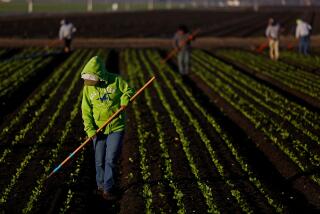Cattlemen Beef About the Lean Times on Range
- Share via
IDAHO FALLS, Ida. — Cattleman Bob Jahn has survived a time when many ranchers decided that a home on the range wasn’t worth singing about, when discouraging words were heard all too often and the financial skies were downright stormy all day.
“Right around here, we’re about the only ones left in the cattle business,” said Jahn, who will be 70 this summer. “Oh, there’s a few, but quite a few have given up.”
His son, Brad Jahn, is among the latter. Cattle he bought from his sister in 1980 became too much of a drain, and he sold them to his father four years later.
“I was having a difficult time, in the cattle price structure we had then, making my payments to my sister and getting any return from what I was doing,” said Jahn, 36, who now feeds other people’s cattle in winter and concentrates on what he calls the “science and art” of growing potatoes. “I couldn’t justify the time I was putting in, in light of what I was getting back” from cattle, he said.
Farmers and ranchers across the West tell a similar story. The 1980s have been a time of high debt and low returns, and many livestock operations have gone under. Americans simply aren’t eating as much hamburger, steak and prime rib as they once did.
“(Prices) started falling in early 1980, and they haven’t recovered,” said agriculture economist Dave Lambert of the University of Nevada-Reno. “The traditional way of life in agriculture is that you hang on and tighten your belt in the bad years, and things get better. What’s been happening is the belts have just been getting tighter and tighter.”
Cattle prices have rebounded this year, by $8 to $9 per 100 pounds, from a year ago. Prices in mid-May ranged from about $55 to slightly more than $71, but for many cattlemen, the damage is done.
“Our numbers are down throughout the United States, but we’ve perhaps been hit harder in the West,” said Dr. Greg Nelson, who heads Idaho’s Division of Animal Industry. “We’ve lost an awful lot of cattlemen in the last five years.”
Industry observers estimate that at least 15% of Idaho’s ranchers and farmers have gone out of business in the last decade, and about a third of the nation’s beef producers are reported to be in financial trouble.
In New Mexico, many pickup trucks bear “Support Beef” bumper stickers. Larry Foster, a beef specialist with New Mexico State University, said he has seen three or four ranches put up for sale every week for the last six months.
“There’s all kinds of reasons,” said Tom Hovendon, executive secretary of the 950-member Idaho Cattlemen’s Assn. “In some cases, it was poor management. In some cases, they decided to expand at the wrong time, and interest rates killed them. People said if you owned land you’d get rich, but they owned land and went broke.”
Some ranchers have made money turning cattle country back into a place where the deer and the antelope--and the hunters--play. In Montana, where some economists predict that only 6,000 of today’s 24,000 ranches will remain by the year 2000, one man has proposed turning an area of 15,000 square miles into a hunting preserve supporting 300,000 head of wild game such as elk and bison.
The Shelton Ranch near Bozeman, Mont., is just launching a commercial hunting operation there that is modeled after its highly successful venture in Texas.
Near Kerrville, Tex., “every rancher in this area depends on (commercial hunting),” said Robert Cook, wildlife biologist for Shelton Ranches. “The cattle industry has been doing very poorly for a long, long time. We have reduced our cattle numbers in Texas substantially, and the bulk of our income and almost all our profit in ranching has come from wildlife management.”
The Shelton operation in Texas books 180 hunters annually, at $1,725 each, for three-day deer hunts. So far, Cook said, a dozen sportsmen have paid $5,500 each for five-day elk hunts on the 107,000-acre Montana spread, which also supports 3,000 head of cattle. Shelton sold off some of the beef herd and opted, like Brad Jahn, to feed other people’s cattle for a price, a move that made good management sense.
Among the survivors in ranching are the big producers whose costs are reduced by volume. Small operations like Foster’s, with 60 head of cattle, depend on income from elsewhere. Bob Jahn conservatively manages 200 to 300 head on land his parents homesteaded at the turn of the century.
“It’s good management, for one thing,” Jahn said. “We’ve been very lucky, and we’ve been very careful all our lives. We watch what we do. I think some went overboard on equipment. They overexpanded. They saw this or that and had to have it.”
In the winter, the Jahns keep their cattle and the cattle Brad feeds on their four farms. They own 640 acres on which they rotate crops of potatoes, grains and alfalfa. Each cow and each crop is an essential part of the Jahns’ thoughtful agricultural equation.
“We can farm a lot more cheaply than people who don’t have the livestock,” said the younger Jahn, stopping his truck to watch a fox skitter across a frozen field. “We probably use half the fertilizers of some people because of the manure and the rotation.”
Each June, Bob Jahn hauls his cattle 70 miles to the family’s 1,000-acre ranch near the Montana state line, where the animals spend the summer feeding and breeding. When Brad owned part of the herd, his all-business approach sometimes conflicted with his father’s more sentimental attitude in matters of livestock.
Cows and Sentiment
“We tested all the cows and anything that wasn’t pregnant we sold, because we knew we had no chance of getting any production from that cow,” Jahn said. “My father and I would disagree about that. Often times, there would be a cow that had been very productive in the herd that didn’t happen to get bred during that season. My philosophy was, we couldn’t afford to keep her, but he was more compassionate. One screw-up wasn’t enough reason in his book to get canned.”
The elder Jahn’s lack of debt meant that he could afford to be charitable. Less fortunate producers have been forced to liquidate their herds in recent years, and this has kept beef supplies high while herds dwindled.
Now the slaughtering is slowing, so there will be less beef on the market and, perhaps, higher prices, industry observers say.
“If the economy stays strong enough, if the poultry people don’t keep producing a lot more chicken, if feed prices don’t suddenly increase--it could mean better times in the next few years,” said Roger Berglund of the National Cattlemen’s Assn.
Fear of Fat Cited
Some ranchers are realizing that they need to improve the image of beef if they’re going to make profits less iffy. Beef consumption has fallen steadily in the last decade as weight-conscious Americans turned to chicken and fish.
A “Real Food for Real People” advertising campaign, financed by voluntary donations from ranchers, emphasizes beef’s nutritional value and primal appeal.
In one ad, actress Cybill Shepherd wonders whether people have an innate desire for hamburgers: “Something hot and juicy and so utterly simple you can eat it with your hands.”
“The country’s on a self-imposed health kick and self-imposed starvation,” said Idaho’s Hovendon. “They’ve had all kinds of funny ideas about what’s good for them. There’s been more phony information, so much you can’t believe it.” Some studies have linked the intake of fat, such as beef fat, to increased risk of heart disease and colon cancer.
Some producers are responding by producing leaner beef. Also, instead being sold in bulk to be cut and wrapped by grocers, beef might be pre-packaged and labeled with brand names, much like Perdue chicken and Oscar Meyer hot dogs. Such consumer-oriented changes have met some resistance in the industry, but economics may have made them imperative.
“There are always going to be the old school of ranchers who just grow what they grow and to hell with what anybody thinks,” said Rick Phillips of the Idaho State Agriculture Department.
“But the beef producer has been forced to look at letting go of the old traditional ways, and take a good, hard look at what is going to sustain the industry in the future.”
More to Read
Sign up for Essential California
The most important California stories and recommendations in your inbox every morning.
You may occasionally receive promotional content from the Los Angeles Times.










